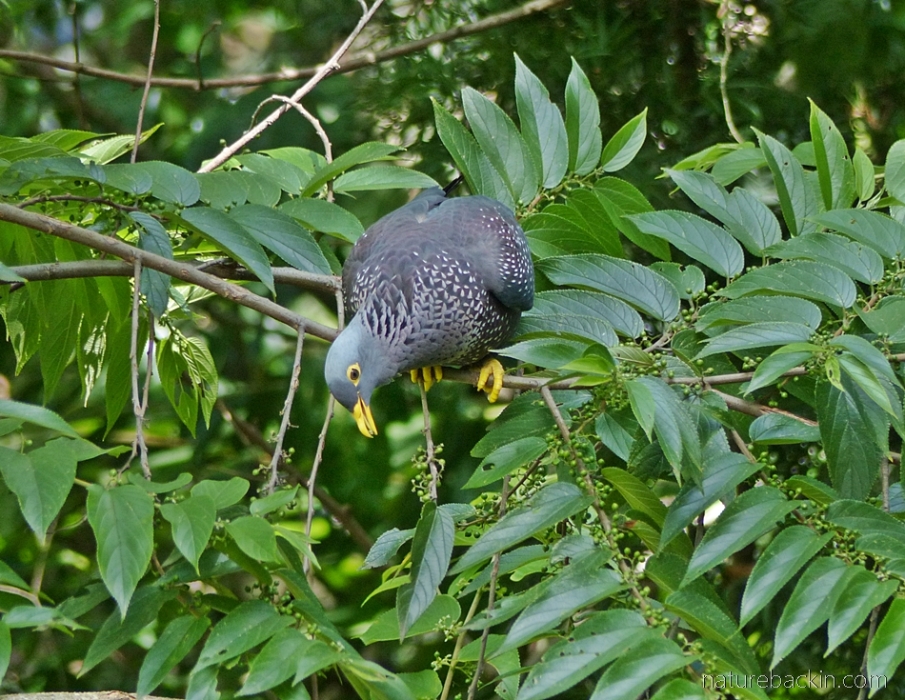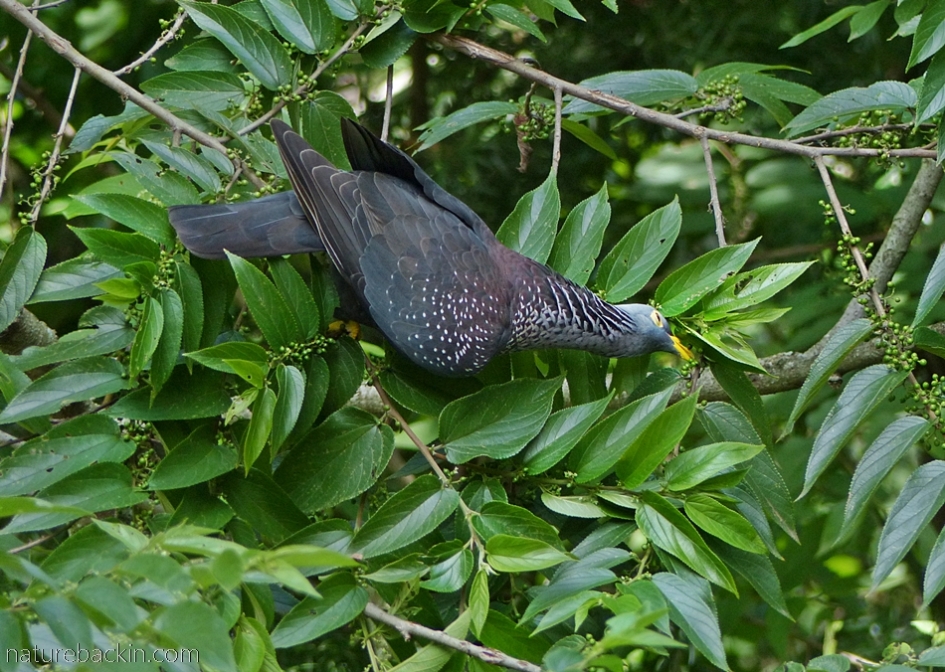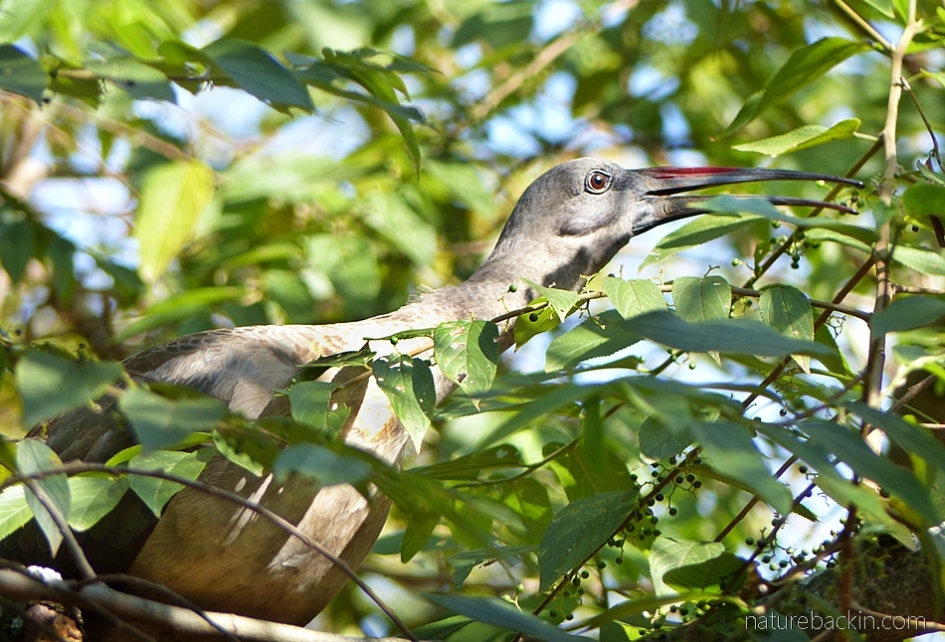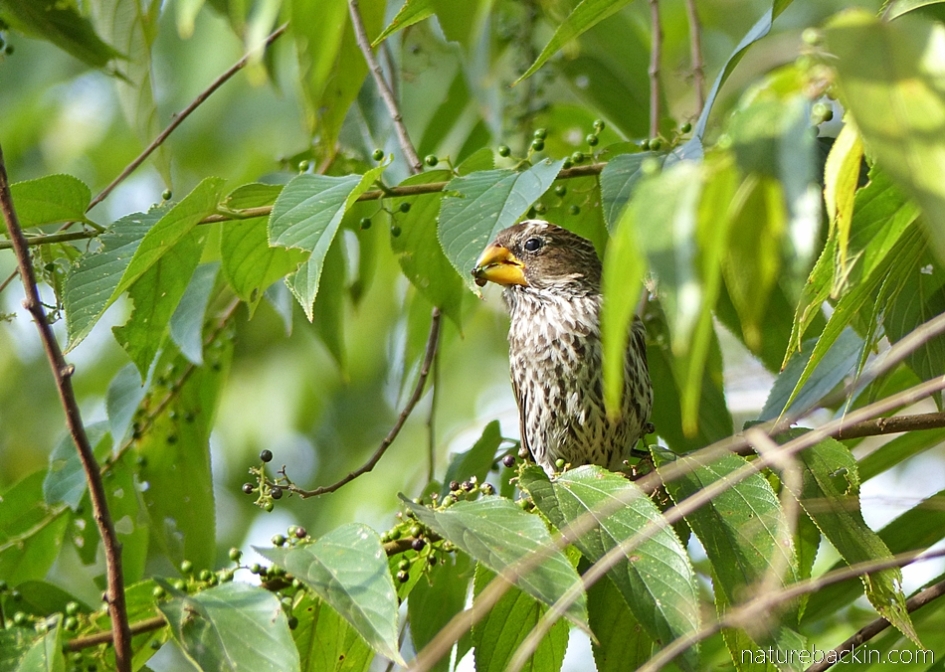The Pigeonwood tree does indeed attract pigeons and many other birds and creatures besides. It is one of the faster growing trees and is a vigorous pioneer plant establishing itself in disturbed soil and along watercourses. It can be useful for new gardens or to provide shelter where other slower growing plants need protection.
Not only is the pigeonwood (Trema orientalis) fast growing, but it thrives in a variety of habitats especially in higher rainfall areas, including along rivers and streams and on forest margins where it can grow to a height of about 18 metres. Where growing in drier conditions it can be quite shrubby in form rather developing as a tree.
In South Africa it occurs in the moister eastern regions, and it occurs further north across much of sub-Saharan Africa and also in tropical Asia and Australia (Queensland). Other common names include the charcoal-tree and the Indian charcoal-tree, and indeed in some countries it is used to make charcoal.

The pigeonwood bears its small fruits, which slowly ripen from green to a dark purple/black, over many months from February to November
Several species of birds are attracted to our pigeonwood trees where they pick fruits directly off the tree, while fruits that have fallen to the ground are eaten by other species of birds, including tambourine doves, lemon doves and mannikins. Although I have not seen them doing this, fruit bats also eat fruits on pigeonwood trees.

African olive-pigeons (formerly rameron pigeons) visit our garden when the pigeonwoods are fruiting. Here is one eating unripened fruit

African olive-pigeons can appear to be quite clumsy as they reach out apparently awkwardly to pluck fruit from slender branches, sometimes flapping their wings to restore their balance

Hadeda ibisis are most commonly seen seeking food on the ground, probing the soil with their long bills for prey. However, they too enjoy the fruits of the pigeonwood somehow managing to delicately pluck the tiny fruit with their disproportionately long bills

More to scale are the Cape white-eyes who arrive in small flocks to move through branches picking fruits as they go

Thick-billed weavers visit our garden during the non-breeding season, when they move to more wooded areas and forests, which is when the pigeonwoods are bearing fruit. During the summer breeding season thick-billed weavers prefer marshes, rivers and dams benefitting from the grasses and reedbeds associated with wetlands

The bark of the pigeonwood is dotted with small raised bumps called lenticels – a new word for me. According to the dictionary, lenticels are raised pores, for example on bark, that allow gas exchange between the atmosphere and the internal tissues of the plant

The lenticels are less apparent on the older wood, which in our garden is covered with decorative species of lichen. A section of the trunk of a pigeonwood sprouts a small shoot of new leaves
The leaves are also a good food source for many creatures and the pigeonwood is a larval host for 14 species of butterfly. A species of leaf beetle is another insect that eats the leaves of the pigeonwood. The leaves are browsed by mammals, including in the wild, giraffe and kudu, and the pigeonwood can also be used to provide fodder for livestock. In some countries where the pigeonwood occurs young leaves are used by people as a type of spinach.

Vervet monkeys seem to enjoy spending time in the pigeonwood trees, as the branches provide suitable places to rest in the shelter of the leaves, and the monkeys also eat young leaves as this one is rather pensively doing

This young vervet monkey is nibbling fruit off a stem of a pigeonwood tree in the garden

It is not only vervet monkeys that like to rest on the branches of the pigeonwood tree. These hadedas are enjoying what used to be a favourite roosting spot, until that particular branch died and eventually broke off
In addition to providing food and shelter, the pigeonwood tree can also provide a playground for young monkeys, as this brief video shows.

Sources:
Boon, Richard. 2010 (2nd ed.). Pooley’s Trees of Eastern South Africa. Durban: Flora & Fauna; Malan, Christien and Notten, Alice. 2005. Trema orientalis. South African National Biodiversity Institute (SANBI). PlantZAfrica,com. http://pza.sanbi.org/trema-orientalis; Roberts VII Multimedia PC Edition. 1997-2016 Southern African Birding. For details go to http://www.sabirding.co.za/roberts7/portal.html
Posted by Carol









July 20, 2020 at 6:03 pm
Delightful, Carol, and so informative. I do appreciate the time and effort which must go into these posts. Hadedas delicately picking the tiny fruit is impressive. And the baby vervets are a joy!
LikeLiked by 1 person
July 22, 2020 at 8:18 pm
Thank you Sandra. The young vervets are indeed a joy 🙂
LikeLiked by 1 person
July 20, 2020 at 8:07 am
Wonderful as usual. Thanks Carol for all the effort and research you put into your articles. Really great.
LikeLiked by 1 person
July 20, 2020 at 5:53 pm
Thanks very much Edith. It is a great tree to have in the garden.
LikeLike
July 18, 2020 at 5:02 am
With those little black berries it looks like the birds are stocking up on spare eyeballs! The monkeys are too cute. It must be a source of continuous entertainment to have them around, though I imagine there’s a downside too. Interesting how a tree or a plant provides so much for so many.
LikeLiked by 1 person
July 20, 2020 at 5:45 pm
What a thought – stocking up on spare eyeballs! 🙂 Very descriptive though.
Yes the monkeys are entertaining. We have developed a way of coexisting happily (for example our veggie patch has a monkey-proof enclosure), but many people have an adversarial relationship with monkeys and expect monkeys to be the ones who should change their ways. Monkeys that are constantly harassed or threatened have a very different demeanour to monkeys in a more harmonious environment where they are a lot more calm, and can settle down to forage and play in a relaxed way. Many people never get to see monkeys that are relaxed and only see them being defensive and tense.
LikeLiked by 1 person
July 21, 2020 at 5:47 am
From the photos I’ve seen of monkeys in your garden, they certainly seem pretty relaxed and happy.
LikeLiked by 1 person
July 18, 2020 at 4:52 am
Your monkeys playing in the pigeon tree look like they know how to have fun. The antics remind me a bit of our acrobatic chipmunks.
LikeLiked by 1 person
July 20, 2020 at 5:37 pm
I didn’t know that chipmunks were also acrobatic! The young monkeys are great to watch as they are so playful.
LikeLiked by 1 person
July 20, 2020 at 9:43 pm
Our chipmunks provide more smiles than I ever could have imagined. The ‘kids’ enjoy chasing each other at incredible speeds, doing somersaults and climbing everything in sight. I’m attempting to do a video, but it’s uphill work. They don’t make catching them at it easy because they move so fast. I call them Zippy! 😉 They’re also pretty bold for their size, chasing larger birds (jays and grosbeaks and quail away from ‘their’ seed stashes.
LikeLiked by 1 person
July 17, 2020 at 12:36 pm
Another refreshing, informative post. The three hadedas made me chuckle, and that final photograph of the pigeon is breathtaking. Have you thought about collating all your posts into a book?
LikeLiked by 1 person
July 17, 2020 at 8:18 pm
Thanks Mariss. I have idly thought about the possibility of a book, but I think it would likely be too photo-heavy to be affordable, apart from all the other possible issues …
LikeLike
July 18, 2020 at 8:33 am
Perhaps an E-Book? Paper publishing of photographic books is difficult, I suppose.
LikeLiked by 1 person
July 20, 2020 at 5:50 pm
Thanks for the encouragement. I will give the idea more thought.
LikeLiked by 1 person
July 17, 2020 at 6:39 am
Now I know something new about a hadeda – fancy them eating berries in a tree!
LikeLiked by 1 person
July 17, 2020 at 7:44 pm
As I said to Dries, perhaps in winter (when the photo was taken) when the ground is dry and hard, hadedas are forced to adapt to eating what is more easily accessible. Although they are often in the pigeonwood trees, when I think about it, I do not often notice them eating the berries.
LikeLiked by 1 person
July 17, 2020 at 4:34 am
Carol this is simply wonderful! It reminds me of a natural equivalent to the children’s story, “The Faraway Tree”! Do you know if the fruit is edible for humans?
Stay safe, with warmest love, xxx
LikeLiked by 1 person
July 17, 2020 at 3:35 pm
Hi Christeen. Thanks. I have read that the fruit is eaten by people in some countries, in addition to the leaves. Most parts of the tree are used extensively in traditional medicines, including the fruit, bark, leaves, seeds and roots. It would seem that its considerable medicinal uses could easily be the subject of an entire post!
Thanks yes you stay safe and warm too xxx
LikeLiked by 1 person
July 24, 2020 at 3:46 am
I would love to know more about the Pigeonwood Tree, perhaps you can do a post? 🙂 xxxx
LikeLiked by 1 person
July 24, 2020 at 10:31 pm
I’ll give it some thought!
LikeLike
July 17, 2020 at 4:19 am
Love this ❤️
LikeLiked by 1 person
July 17, 2020 at 3:18 pm
Thank you Debs xxx
LikeLike
July 17, 2020 at 3:07 am
What a wonderful addition to any indigenous South African garden, Carol, and such a diversity of animals making good use of the bounty provided! I was amazed to see your photo of the hadeda picking fruit from the tree; I’ve never seen that before and was obviously mistaken in my understanding that they feed only on worms, slugs and other invertebrates.
LikeLiked by 1 person
July 17, 2020 at 3:18 pm
Well the bird reference books also do not record hadedas as eating fruit. The photo was taken in July (in 2016 in fact) when the winter ground is very dry and hard and so probing the soil for prey is very difficult. Perhaps in such dry times they are forced to resort to eating whatever is accessible, including tiny fruits.
LikeLiked by 1 person
July 18, 2020 at 5:07 am
Fascinating behaviour to have photographic proof of, Carol. And that in your own garden too!
LikeLiked by 1 person
July 20, 2020 at 5:46 pm
I must pay more attention in future to the hadedas’ foraging habits!
LikeLiked by 1 person
July 17, 2020 at 1:35 am
Oh, those monkeys are hilariously funny! Such fun.
Pigeonwood is a handsome and quite useful tree. Thanks for the great introduction, Carol.
LikeLiked by 1 person
July 17, 2020 at 3:11 pm
Thank you Eliza. The young monkeys are so engaging and entertaining.
I only learnt when doing this post that the distribution of the pigeonwood extends beyond Africa to many countries and regions in Asia too.
LikeLiked by 1 person
July 16, 2020 at 9:05 pm
The range of visitors the pigeonwood tree attracts seems impossibly exotic to me. How exciting to witness such variety. A delightful short video – thanks!
LikeLiked by 1 person
July 17, 2020 at 3:08 pm
The variety is interesting and not to be taken for granted! Glad you enjoyed the video of the delightful young vervets.
LikeLike
July 17, 2020 at 4:19 pm
Oh, I did. No Social Distancing there!
LikeLiked by 1 person
July 20, 2020 at 5:25 pm
🙂
LikeLike